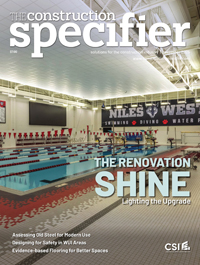Concrete moisture mitigation to help floors
 FAILURES
FAILURES
Emily R. Hopps
Concrete floor slabs contain excess moisture that can damage many types of floor finishes. To address this problem, manufacturers have developed products aimed at mitigating the moisture in concrete. However, not all these products are suited to their intended purpose.
There are various materials for retarding emission of moisture vapor from concrete floor slabs, many of which are topical treatments applied to the slab surface before finishes are installed. Investigations have revealed there are multiple factors that can contribute to failure of these products.
A critical characteristic of a vapor-retarding coating is its permeability, which measures the degree to which moisture vapor can pass through the coating. The permeability must be less than that of the overlying flooring so any moisture vapor passing through the coating will not be trapped below the flooring, breaking down the adhesive bond to the slab.
Permeance testing, usually following ASTM E96/E95M, Standard Test Method for Water Vapor Transmission of Materials, is a long-term test most applicable to the expected in-service exposure of the coating or treatment. Shorter-term tests of moisture vapor emission, such as ASTM F1869, Standard Test Method for Measuring Moisture Vapor Emission Rate of Concrete Subfloor Using Anhydrous Calcium Chloride, will not provide a valid indication of the treatment’s expected long-term performance.
Permeance is directly related to coating thickness—there have been moisture mitigation failures of well-formulated coatings due to inadequate application thickness and continuity. However, even coatings with the right permeance, thickness, and continuity can fail when they are not formulated to withstand the moisture and high alkalinity (i.e. pH) of the concrete substrate. Many typical coating materials and formulations are unsuitable for the conditions to which they will be exposed when applied onto a slab below low-permeability floor finishes. There have been cases where the coating’s formulation was not robust enough for this exposure, which led to excessive moisture vapor emissions and floor finish failure.
To avoid the issues associated with developing and properly applying moisture mitigation coatings to slab surfaces, some manufacturers have developed admixtures for the concrete to reduce moisture vapor emissions. Mixed into the wet concrete, these materials typically do not require additional topical treatments before the finishes are installed.
Investigations have shown some admixtures may reduce concrete porosity, making it more difficult to achieve proper adhesion of the floor finishes. Studies have also revealed some admixtures may not adequately reduce moisture vapor emissions to prevent moisture-related failure, may increase the concrete surface pH, and may increase potential for a layer of bond-inhibiting surface laitance.
Since both topical and admixture moisture mitigation products have a history of failure, the ASTM committee responsible for overseeing resilient flooring installation recently developed a standard for moisture mitigation materials. ASTM F3010, Standard Practice for Two-Component Resin Based Membrane-Forming Moisture Mitigation Systems for Use Under Resilient Floor Coverings, was published in July 2013. It includes many requirements to help designers and contractors review, select, and install floor moisture mitigation products.
The new standard includes requirements for material characteristics (e.g. permeability), concrete surface preparation, mockup installations, and quality control testing (e.g. adhesion testing and thickness measurements). It may not prevent all future flooring failures, but it goes a long way in helping all stakeholders better understand the important criteria of moisture mitigation materials and be appropriately cautious when selecting a material or system for their next project.
Emily R. Hopps is a senior project manager in the Building Technology division of Simpson Gumpertz & Heger Inc. (SGH). Leading SGH’s flooring practice, she has wide experience in the design, failure investigation, and repair of various finishes. Hopps can be reached at erhopps@sgh.com.


